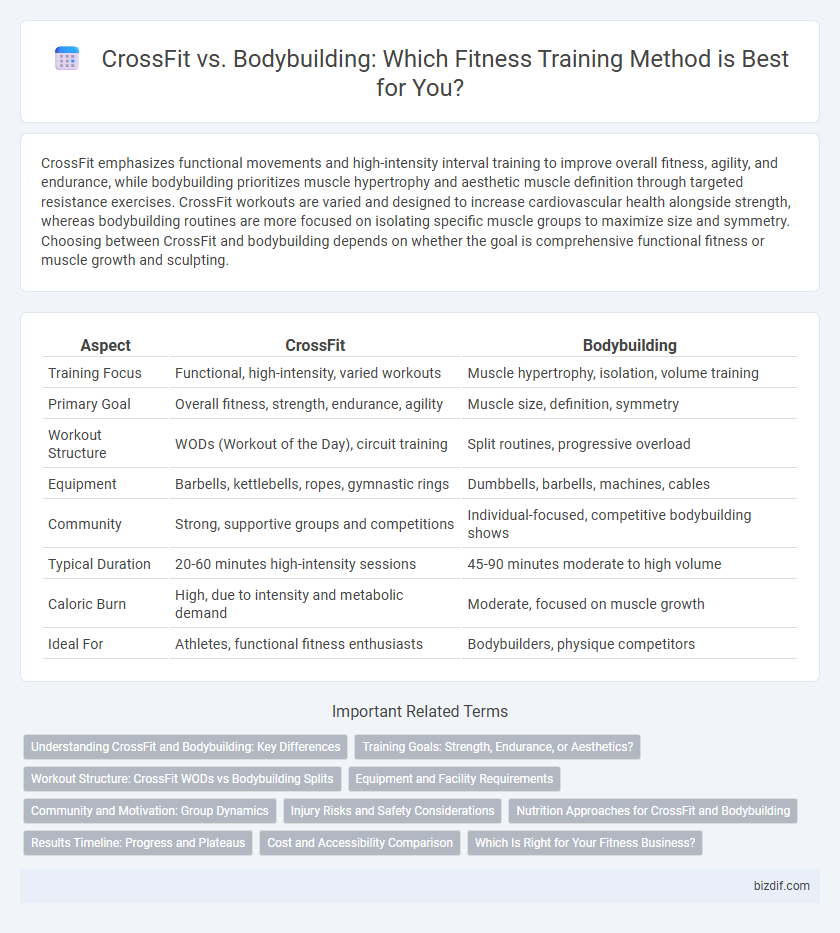CrossFit emphasizes functional movements and high-intensity interval training to improve overall fitness, agility, and endurance, while bodybuilding prioritizes muscle hypertrophy and aesthetic muscle definition through targeted resistance exercises. CrossFit workouts are varied and designed to increase cardiovascular health alongside strength, whereas bodybuilding routines are more focused on isolating specific muscle groups to maximize size and symmetry. Choosing between CrossFit and bodybuilding depends on whether the goal is comprehensive functional fitness or muscle growth and sculpting.
Table of Comparison
| Aspect | CrossFit | Bodybuilding |
|---|---|---|
| Training Focus | Functional, high-intensity, varied workouts | Muscle hypertrophy, isolation, volume training |
| Primary Goal | Overall fitness, strength, endurance, agility | Muscle size, definition, symmetry |
| Workout Structure | WODs (Workout of the Day), circuit training | Split routines, progressive overload |
| Equipment | Barbells, kettlebells, ropes, gymnastic rings | Dumbbells, barbells, machines, cables |
| Community | Strong, supportive groups and competitions | Individual-focused, competitive bodybuilding shows |
| Typical Duration | 20-60 minutes high-intensity sessions | 45-90 minutes moderate to high volume |
| Caloric Burn | High, due to intensity and metabolic demand | Moderate, focused on muscle growth |
| Ideal For | Athletes, functional fitness enthusiasts | Bodybuilders, physique competitors |
Understanding CrossFit and Bodybuilding: Key Differences
CrossFit emphasizes functional movements performed at high intensity to improve overall fitness, combining elements of weightlifting, cardio, and gymnastics. Bodybuilding primarily focuses on hypertrophy through targeted resistance training to sculpt muscle size and definition. Understanding these core differences in training goals and methodologies highlights how CrossFit aims for versatile athleticism while bodybuilding targets aesthetic muscle development.
Training Goals: Strength, Endurance, or Aesthetics?
CrossFit emphasizes functional strength and endurance through high-intensity, varied workouts designed to improve overall fitness and cardiovascular capacity. Bodybuilding prioritizes muscle hypertrophy and aesthetics, focusing on isolated resistance training to sculpt and define muscle groups. Selecting between CrossFit and bodybuilding depends on whether the primary goal is enhanced functional performance or muscular appearance.
Workout Structure: CrossFit WODs vs Bodybuilding Splits
CrossFit WODs (Workouts of the Day) emphasize varied, high-intensity functional movements combining cardio, weightlifting, and gymnastics performed in short, intense sessions to develop overall fitness. Bodybuilding splits focus on targeting specific muscle groups with isolated exercises, following a structured, lower-intensity routine spread across multiple days to maximize hypertrophy. CrossFit training enhances endurance, strength, and agility simultaneously, while bodybuilding prioritizes muscle size and definition through volume and muscle fatigue.
Equipment and Facility Requirements
CrossFit requires versatile equipment such as kettlebells, barbells, plyometric boxes, and rowing machines, typically found in specialized gyms equipped for high-intensity functional training. Bodybuilding focuses more on weight machines, free weights, dumbbells, and benches, with a gym layout optimized for isolated muscle group exercises. CrossFit facilities, or "boxes," often have open floor plans for dynamic workouts, while bodybuilding gyms feature more stations dedicated to strength training with heavier weights.
Community and Motivation: Group Dynamics
CrossFit excels in fostering a strong community through group workouts and competitive events, creating a motivating environment driven by shared goals and camaraderie. Bodybuilding often emphasizes individual progress but benefits from gym-based support networks and mentorship that encourage consistent discipline. The group dynamics in CrossFit typically enhance motivation more directly by offering immediate social reinforcement and accountability.
Injury Risks and Safety Considerations
CrossFit training involves high-intensity, functional movements that may increase the risk of acute injuries such as strains, sprains, and rhabdomyolysis, especially without proper technique and supervision. Bodybuilding typically emphasizes controlled, isolated movements with moderate to heavy weights, reducing the likelihood of sudden injuries but potentially causing chronic issues like tendonitis or joint stress from repetitive loads. Prioritizing appropriate warm-up routines, progressive overload principles, and personalized coaching can significantly mitigate injury risks in both CrossFit and bodybuilding training programs.
Nutrition Approaches for CrossFit and Bodybuilding
CrossFit nutrition emphasizes high protein intake combined with balanced carbohydrates and fats to fuel intense, varied workouts and support recovery in metabolic conditioning and strength training. Bodybuilding nutrition prioritizes calorie surplus with precise macronutrient ratios, focusing on protein for muscle hypertrophy and carbohydrate cycling to optimize muscle glycogen replenishment during bulking and cutting phases. Both approaches demand nutrient timing and hydration strategies tailored to their specific training intensities and goals for maximal performance and body composition.
Results Timeline: Progress and Plateaus
CrossFit delivers rapid improvements in cardiovascular endurance and overall functional strength within the first 4 to 8 weeks, promoting diverse muscle engagement and reduced risk of plateaus. Bodybuilding shows noticeable muscle hypertrophy and definition typically after 12 to 16 weeks of consistent resistance training, with plateaus common around 6 months without progressive overload adjustments. Tracking periodized workout routines and nutrition closely accelerates progress and minimizes stagnation in both fitness regimes.
Cost and Accessibility Comparison
CrossFit memberships typically range from $150 to $300 per month, often including specialized coaching and access to group classes, while bodybuilding gyms usually offer more affordable monthly fees between $10 and $50 but may lack personalized guidance. CrossFit requires access to specific equipment like barbells, kettlebells, and rowing machines, which can limit accessibility, whereas bodybuilding facilities generally provide standard weight machines and free weights found in most gyms. The higher cost and specialized nature of CrossFit can create barriers for some, whereas bodybuilding offers greater accessibility due to its widespread availability and lower financial commitment.
Which Is Right for Your Fitness Business?
CrossFit offers a dynamic, high-intensity workout model that appeals to clients seeking varied and scalable functional fitness, ideal for businesses aiming to attract a broad demographic. Bodybuilding centers on hypertrophy and muscle definition, catering to individuals focused on aesthetics and strength, making it suitable for gyms targeting niche markets with specialized equipment. Choosing between CrossFit and bodybuilding depends on your fitness business goals, client base preferences, and facility capabilities to deliver tailored training experiences.
CrossFit vs Bodybuilding Infographic

 bizdif.com
bizdif.com